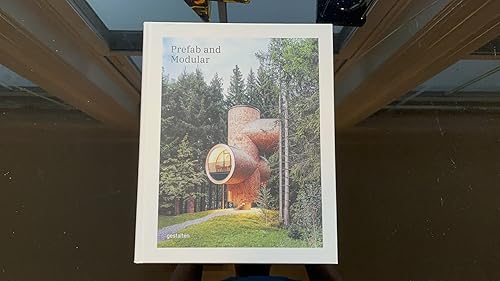In today’s fast-paced world, the demand for innovative housing solutions is growing. The book, “Prefab and Modular: Prefabricated Houses and Modular Architecture,” explores exciting advancements in modular construction. This beautifully curated collection showcases how prefabricated homes and buildings offer practical and stylish options for modern living.
Readers will find an array of residential and public projects that demonstrate the versatility and efficiency of modular design. With so many unique ideas presented, this book appeals to both professionals in architecture and everyday property owners. It shows how prefab and modular solutions can help create functional spaces that meet diverse needs without sacrificing aesthetics.
By diving into the pages of this book, one can discover the potential of prefabricated architecture. From cozy cabins to sleek urban homes, each project reflects the endless possibilities available. This book is a must-read for anyone interested in the future of home design and construction.
Exploring the World of Prefabricated Houses
Prefab houses have transformed modern living. With a rich history, distinct benefits, and innovative materials, these structures are becoming a popular choice for many.
The History and Evolution of Prefab Homes
Prefab homes date back to the early 20th century. Initially, they were built rapidly after World War II to provide affordable housing for returning soldiers. The demand led to advancements in modular design and construction techniques.
Over the decades, prefab houses evolved in style and functionality. Designers began incorporating more aesthetic elements, moving away from the basic structures of the past. Today, these homes showcase a blend of creativity and efficiency, appealing to a wider audience looking for unique housing solutions.
Benefits of Prefab Construction
There are several key advantages to prefabricated homes. First, they can be constructed much faster than traditional homes, often within a few months. This efficiency saves time and reduces labor costs.
Additionally, prefab homes often use high-quality materials and adhere to strict building codes. This results in sturdy structures that can withstand various environmental factors. Many also offer sustainability benefits, as they can be designed to be energy-efficient, reducing long-term utility costs for homeowners.
Materials and Technologies in Prefab Building
The materials and technologies for prefab buildings have advanced significantly. Manufacturers often use steel, wood, and advanced composites for durability and lightweight construction. These materials allow for better insulation and lower energy consumption.
Modern prefab homes also utilize smart home technology. Features like energy-efficient appliances and automated systems make life easier for homeowners. As these innovations become more widespread, the appeal of prefab living continues to grow in the housing market.
Diving into Modular Architecture
Modular architecture is characterized by innovative design principles and construction methods. This approach allows for flexibility and efficiency in building structures. Understanding these aspects helps to appreciate the growing popularity of modular designs.
Understanding Modular Design Principles
Modular design revolves around creating structures from prefabricated sections or “modules.” These modules can be built off-site and then transported for assembly. The emphasis on standardization allows for quicker construction times and reduced waste.
Key principles include:
- Flexibility: Modules can be arranged in various configurations.
- Sustainability: Using less material and minimizing site disturbance is crucial.
- Cost-effectiveness: Streamlining the building process helps keep costs down.
Many projects utilize this approach to create homes, offices, and even schools, adapting to various needs while maintaining a modern aesthetic.
Innovations in Modular Construction
Recent advancements in technology have transformed modular construction. Techniques such as 3D printing and computer-aided design (CAD) are being integrated into the process. These innovations enhance precision and creativity in design.
Some notable innovations include:
- Smart Modules: Incorporating technology for energy efficiency.
- Eco-friendly Materials: Using sustainable resources reduces environmental impact.
- Customizable Designs: Clients can personalize their spaces while still benefiting from modular efficiencies.
These developments are reshaping how communities and buildings are planned and constructed, showing that modular architecture is at the forefront of modern design.
Case Studies and Project Highlights
Prefab and modular architecture are gaining attention for their innovative approaches and unique designs. This section explores notable examples from around the world, highlighting their features and contributions to modern living.
Iconic Prefab Homes Around the World
Prefab homes blend creativity with efficiency. One remarkable example is the Koda by Kodasema. This compact dwelling can be set up in just a few days, making it an ideal choice for those seeking quick and stylish living solutions.
Another standout is the Nesthouse in Wisconsin. This home features eco-friendly materials and a striking design. Its ability to integrate with the surrounding nature exemplifies how prefab homes can enhance their environments.
Additionally, the Wolverine home is designed for energy efficiency. Special attention to insulation keeps it warm in winter and cool in summer. These unique homes offer a glimpse into the future of sustainable living.
Exceptional Modular Architectural Projects
Modular architecture allows for smart design and quick construction. A prime example is the Mayfair project, which faced design challenges yet transformed into a stunning modular building. The collaboration between architects and engineers resulted in an innovative façade that impressed many.
Another noteworthy project is the Happy House, built using advanced modular techniques. This project showcases flexibility and efficiency in construction while maintaining modern aesthetics.
Lastly, the Copenhagen Harbour Bath demonstrates how modular design can integrate into public spaces. This vibrant community area provides recreation while emphasizing sustainability, highlighting the diverse applications of modular architecture.
